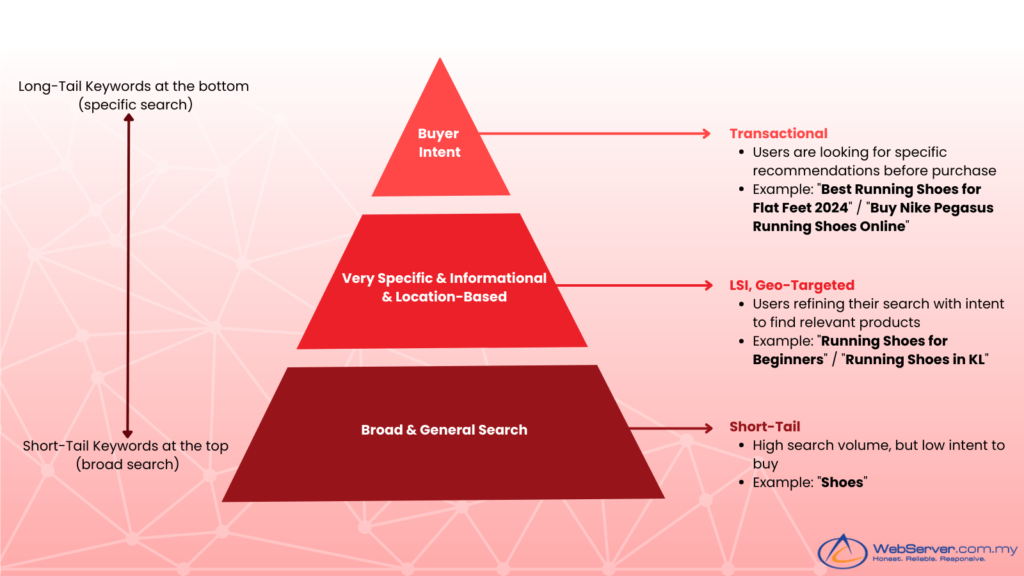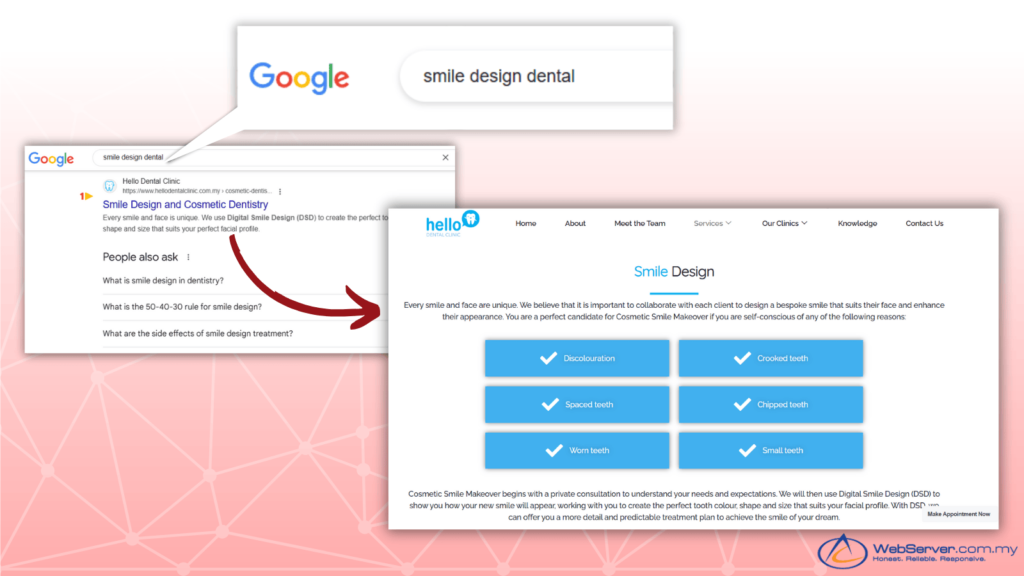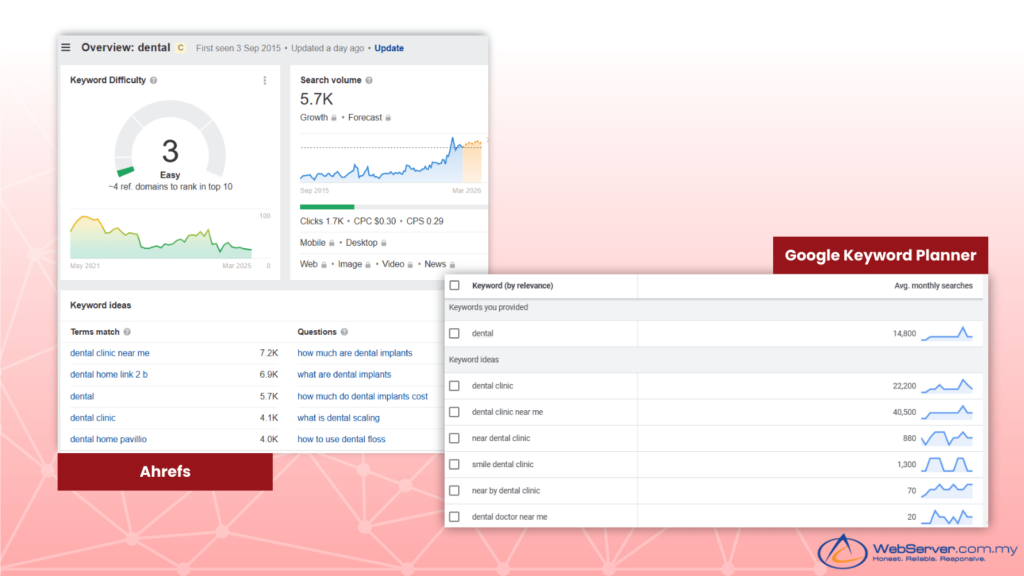-
Sales +603 2770 2833
- sales@webserver.com.my
What is the main purpose of using keyword in SEO
Table of Contents
ToggleIn today’s digital landscape, Search Engine Optimization (SEO) is a critical strategy for increasing a website’s visibility and driving organic traffic. At the heart of this strategy lies the keywords, which are the terms and phrases that users enter into search engines when looking for information. But what exactly is the main purpose of using keywords in SEO? This article delves into the importance of keywords, exploring how they act as the building blocks of effective SEO campaigns.
Purpose of Keywords
Helping Search Engines Understand Content
Keywords are fundamental to how search engines comprehend the content of a webpage. When search engines crawl and index pages, they analyze the text to identify the most relevant topics and themes. Keywords act as signals that guide search engines in deciphering the subject matter of the content. By strategically placing appropriate keywords throughout a webpage—including in titles, headings, meta descriptions, and body text—webmasters can effectively communicate the core topics to search engines.
For example, if a webpage is about “sustainable gardening practices,” using this phrase and related terms like “eco-friendly gardening” and “organic gardening” helps search engines understand that the content is centered on environmentally conscious gardening methods.
Matching User Queries with Relevant Content
The main objective of search engines is to provide users with the most relevant and helpful results based on their queries. Keywords are essential to this process, as they connect what users are searching for with the available web content. When users type specific terms or phrases into a search engine, it searches its index for pages that contain those keywords or closely related terms.
A user searching for “best plants for indoor air quality” will find pages that use keywords such as “indoor plants,” “air-purifying plants,” and “best houseplants for clean air.” By incorporating these commonly searched keywords into webpage content, webmasters boost the likelihood of their pages appearing in search results for related queries.
Understanding user intent in search queries is essential. Keywords indicate whether users seek information, purchase, or navigate to a specific site. For example, “how to grow tomatoes” shows informational intent, while “buy organic tomato seeds” shows transactional intent. By optimizing content with relevant keywords, webmasters can better meet user needs and improve engagement and satisfaction.
Types of Keywords

Short-Tail Keywords:
Also known as head keywords, short-tail keywords are typically one to two words long and are very broad in nature. They tend to have a high search volume but also a lot of competition.
Example: “Shoes,” “Gardening”
Long-Tail Keywords:
These are more specific and usually consist of three or more words. They have a lower search volume compared to short-tail keywords but often convert better because they target a more precise audience.
Example: “Best running shoes for flat feet,” “Organic vegetable gardening tips”
LSI (Latent Semantic Indexing) Keywords:
LSI keywords are terms and phrases that are semantically related to your main keyword. They help search engines understand the context of your content better.
Example: For the main keyword “Apple,” LSI keywords could include “fruit,” “orchard,” “nutrition,” and “healthy eating.”
Geo-Targeted Keywords:
These keywords include a geographical component and are used to target a specific location. They are particularly useful for businesses that operate in certain areas or cities.
Example: “Best sushi restaurant in Tokyo,” “Plumber in Los Angeles”
Transactional Keywords:
These keywords indicate an intent to purchase and are highly valuable for e-commerce sites. They typically include words like “buy,” “discount,” “deal,” or “sale.”
Example: “Buy iPhone 12,” “Discount running shoes”
Keyword Research

Why keyword is important in SEO:
So, why keyword research is important in SEO?
Keyword research is essential for a successful SEO strategy. By targeting the right keywords, you can align your content with what your audience is searching for, which increases your website’s visibility in relevant search results and drives organic traffic. Effective keyword research helps you understand potential customer queries, enabling you to create content that meets their needs. Without proper keyword research, you risk losing valuable traffic and not connecting with your target audience.
Popular Keyword Research Tools and Techniques:
- Google Keyword Planner:
- A free tool that provides insights into keyword search volumes, competition, and trends. It’s great for discovering new keywords and understanding their potential impact.
- A free tool that provides insights into keyword search volumes, competition, and trends. It’s great for discovering new keywords and understanding their potential impact.
- Ahrefs:
- Get the most out of your SEO strategy with our tool. It offers detailed keyword analysis, including search volume, difficulty, and competitor insights. Identify the keywords your competitors rank for and find opportunities to boost your rankings.
- Get the most out of your SEO strategy with our tool. It offers detailed keyword analysis, including search volume, difficulty, and competitor insights. Identify the keywords your competitors rank for and find opportunities to boost your rankings.
- SEMrush:
- This tool offers detailed keyword data such as search volume, difficulty, and competitive analysis. It includes features like keyword gap analysis and content ideas based on trending keywords.
- This tool offers detailed keyword data such as search volume, difficulty, and competitive analysis. It includes features like keyword gap analysis and content ideas based on trending keywords.
- Moz Keyword Explorer:
- Moz’s tool offers keyword suggestions, search volume, difficulty scores, insights into SERP features, and organic click-through rates.
- Moz’s tool offers keyword suggestions, search volume, difficulty scores, insights into SERP features, and organic click-through rates.
- Ubersuggest:
- A straightforward tool that provides keyword suggestions, search volume, and competitive analysis. It helps identify long-tail keywords and assess competitor performance.
- A straightforward tool that provides keyword suggestions, search volume, and competitive analysis. It helps identify long-tail keywords and assess competitor performance.
- Keywords Everywhere:
- A browser extension that displays keyword data in your search results, including search volume, CPC, and competition, for quick research.
Techniques:
- Brainstorming: Start by brainstorming a list of potential keywords relevant to your niche. Consider the terms your audience might use when searching for your products or services.
- Analyzing Competitors: Look at the keywords your competitors are targeting. Tools like Ahrefs and SEMrush can help you uncover these keywords and identify gaps in your strategy.
- Using Google Autocomplete: Type your main keywords into Google and see what suggestions come up. This can give you ideas for additional keywords and show you what people are commonly searching for.
- Exploring Related Searches: Check the “Related searches” section at the bottom of Google’s search results page for more keyword ideas.
- Long-Tail Keywords: Focus on long-tail keywords, which are more specific and often less competitive. These keywords can help you attract targeted traffic more likely to convert.
Implementing Keywords

Best Practices for Incorporating Keywords:
- Titles:
- Place the primary keyword at the beginning of the title if possible. This enhances its prominence and relevance for search engine algorithms.
- Ensure the title is compelling and accurately represents the content of the page.
- Example: “Effective Gardening Tips: How to Grow Organic Vegetables at Home”
- Meta Descriptions:
- Include the main keyword within the meta description to provide a clear summary of the page’s content.
- Keep the meta description concise, engaging, and around 150-160 characters.
- Example: “Discover top tips for organic vegetable gardening at home. Learn how to grow healthy, eco-friendly plants with our expert guide.”
- Headers:
- Use keywords in H1, H2, and H3 tags to structure your content and highlight key sections.
- Ensure headers are descriptive and provide a clear outline of the content.
- Example: H1: “Organic Vegetable Gardening Guide” H2: “Choosing the Right Soil” H3: “Benefits of Organic Fertilizers”
- Body Text:
- Naturally incorporate keywords into the body text without forcing them. Aim for a keyword density of around 1-2%.
- Use variations and synonyms to avoid repetitive phrasing and to enhance the readability of your content.
- Example: “Growing organic vegetables at home can be both rewarding and beneficial. By choosing the right soil and using organic fertilizers, you can ensure your plants thrive.”
- URLs:
- Include keywords in the URL to give search engines additional context about the page’s content.
- Keep URLs short and descriptive.
- Example: “www.example.com/organic-vegetable-gardening-tips”
Avoiding Keyword Stuffing:
Keyword stuffing is the excessive use of keywords in an attempt to manipulate search rankings. This practice can lead to a poor user experience and can be penalized by search engines. Here are key tips to avoid keyword stuffing and maintain natural, readable content:
- Focus on Quality: Prioritize high-quality, informative content that addresses the needs of your audience.
- Use Synonyms and Related Terms: Vary your language to keep the content engaging and to cover related topics comprehensively.
- Write for Humans: While it’s important to optimize for search engines, always write with your audience in mind. Ensure the content flows naturally and is easy to read.
- Monitor Keyword Density: Aim for a balanced approach, avoiding overuse of any particular keyword.
Measuring Search Engine Optimization Success

Tracking Keyword Performance Using Analytics Tools:
To gauge the effectiveness of your keyword strategy, it’s essential to track performance using various analytics tools. Here are some widely-used tools and how they can help:
- Google Analytics:
- Provides insights into organic traffic, showing how visitors find and interact with your site.
- Offers data on user behavior, such as time spent on page, bounce rate, and conversion rates.
- Helps identify which keywords are driving traffic and how those visitors are engaging with your content.
- Google Search Console:
- Tracks search performance, including impressions, clicks, and average position for specific keywords.
- Highlights issues with indexing, crawl errors, and mobile usability that could affect keyword performance.
- Offers data on search queries, helping you understand which keywords are bringing users to your site.
- SEMrush:
- Provides comprehensive keyword tracking, including search volume, keyword difficulty, and competitive analysis.
- Monitors changes in search engine rankings over time for your targeted keywords.
- Offers insights into backlink profiles, which can impact keyword performance.
- Ahrefs:
- Tracks keyword rankings and provides insights into search traffic and organic keywords.
- Analyzes competitor keywords and content to identify opportunities for improvement.
- Provides data on backlink growth and the impact on keyword performance.
Key Metrics to Monitor:
- Search Engine Rankings:
- Monitor the position of your targeted keywords in search engine results pages (SERPs).
- Higher rankings indicate better visibility and relevance for those keywords.
- Organic Traffic:
- Track the number of visitors arriving at your site through organic search results.
- An increase in organic traffic suggests that your keyword strategy is effectively attracting users.
- Click-Through Rates (CTR):
- Measure the percentage of users who click on your site from the search engine results.
- A higher CTR indicates that your titles and meta descriptions are compelling and relevant to searchers.
- Bounce Rate:
- Track the percentage of visitors who leave your site after viewing only one page.
- A high bounce rate could indicate that your content isn’t meeting user expectations or needs improvement.
- Conversion Rate:
- Measure the percentage of visitors who complete a desired action, such as making a purchase or filling out a contact form.
- Higher conversion rates suggest that your keywords are attracting relevant, high-quality traffic.
Conclusion
This article highlights the essential role of keywords in Search Engine Optimization (SEO). We explained how keywords help search engines match webpage content with user queries. We covered keywords—short-tail, long-tail, LSI, geo-targeted, and transactional—along with their specific uses and advantages.
We stressed the importance of thorough keyword research for identifying effective keywords and introduced popular tools and techniques. Additionally, we provided best practices for incorporating keywords into content, including titles, meta descriptions, headers, and body text, while avoiding keyword stuffing for better readability.
Effective keyword usage is essential for a successful SEO strategy. Mastering keyword research and implementation can improve your website’s visibility, attract targeted organic traffic, and reach your SEO goals. Keyword optimization is not just about rankings; it’s about engaging your audience with valuable, relevant content.
Reach out to us to subscribe to SEO in Malaysia.

WebServer.com.my, a business unit of a privately owned Acme Commerce Sdn Bhd was established in 1989. Specializes in the complex managed hosting services such as database hosting and mission critical application hosting since 1999.
-
Office Hour
+603 2770 2833 -
Extended
+603 2770 2803 -
Email
sales@webserver.com.my -
Technical Support
support@webserver.com.my
Switch The Language




